Chengdu is not only Malatang--Wanli Tour on the Western Ring Road (2)
Chengdu 1

kuanzhai alley
Kuanzhai Alley is located in Qingyang District. It is an ancient street left over from the Qing Dynasty and is known as one of the "Top Ten Most Beautiful Streets in Sichuan."

Kuanzhai Alley 1
During the Kangxi years, after the Jungar Rebellion was put down, soldiers were left to garrison Chengdu and a "Mancheng" was built for the flag bearers to live in. With the fall of the Qing Dynasty,"Mancheng" was no longer a restricted area. Famous people such as Yu Youren, Yang Sen, Liu Wenhui and some ordinary people once settled here. At this time, the wide alley was called "Xingren Hutong" and the narrow alley was called "Taiping Hutong".

Kuanzhai Alley 2
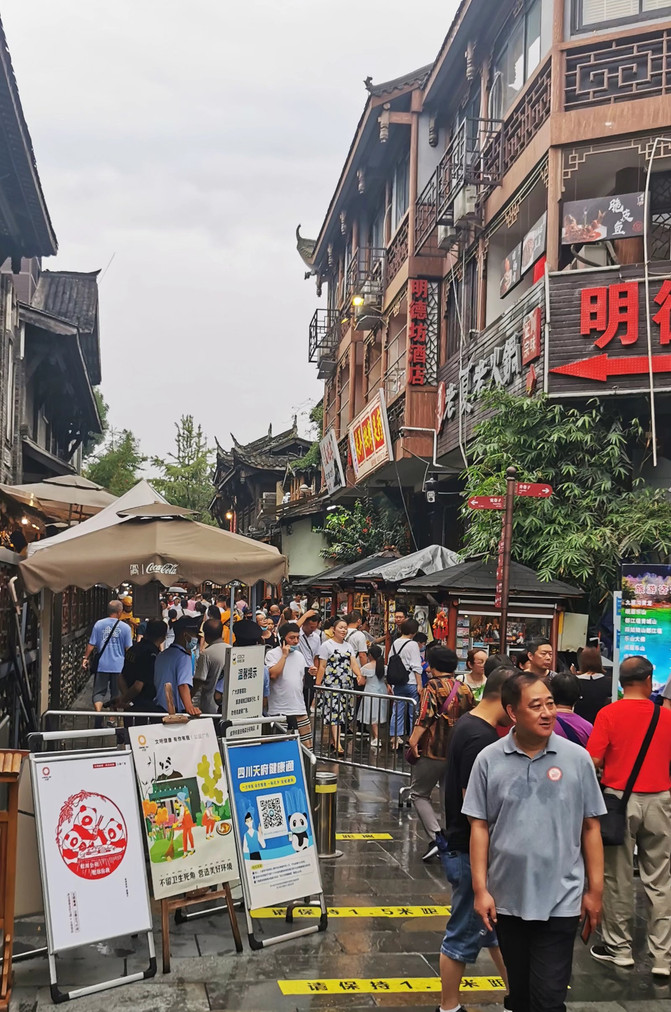
Kuanzhai Alley 3
In the early years of the Republic of China,"Hutong" was changed to "Alley". During the urban survey, the staff casually marked the wider alleys as "wide alleys" and the narrower ones as "narrow alleys", so they were called "wide and narrow alleys".

Kuanzhai Alley 4

Kuanzhai Alley 5
Since the 1980s, the wide and narrow alleys have been transformed into a commercial street with regional characteristics and Bashu cultural atmosphere mainly for tourism and leisure.

Kuanzhai Alley 6

Kuanzhai Alley 7
There are many buildings in the wide alleys from the late Qing Dynasty and the early Republic of China, as well as some Western-style buildings that express the living environment of old Chengdu.

Kuanzhai Alley 8
Narrow alleys feature bars, restaurants, art and leisure themed shops, etc., showing the "slow life" of old Chengdu.
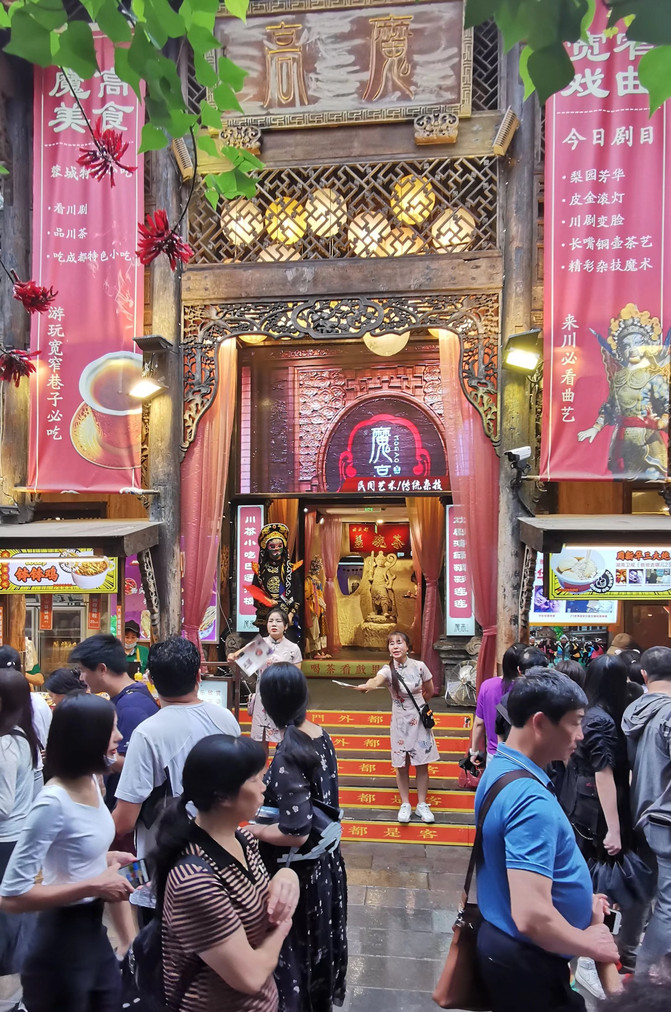
Kuanzhai Alley 9

Kuanzhai Alley 10
There are many tourists, mainly young people, and it is estimated that there are not many locals. For us old travel friends, it is purely to join in the fun.
On July 10, we visited Wuhou Temple and Du Fu Cottage in the morning. The Chengdu Public Transport "Jincheng Sightseeing Line" is a circular line that connects major scenic spots in the urban area. Line 1 runs clockwise and Line 2 runs counterclockwise. The fare is 2 yuan, which solves the problem of self-driving parking in the urban area. It is very convenient.
I came early and the Wuhou Temple was not open yet, so I should take a look around first.
jinli

In recent years, Chengdu has newly opened the "Jinli" ancient street on the east side of Wuhou Temple and incorporated the "Southern Suburb Park" on the west side, expanding the scale of the scenic spot and adding new attractions.

Jinli 2

Jinli 3
Jinli, located on the east side of Wuhou Temple, is said to have been the oldest and most commercial street in the history of Western Shu. Whether this is true or not, it is now based on the Wuhou Temple, based on the architectural style of Sichuan houses in the late Qing Dynasty and the early Republic of China, with the culture of the Three Kingdoms and traditional Sichuan folk customs as its connotation, and integrates food, housing, travel, travel, shopping and entertainment. New highlights. Antique and good imitation.
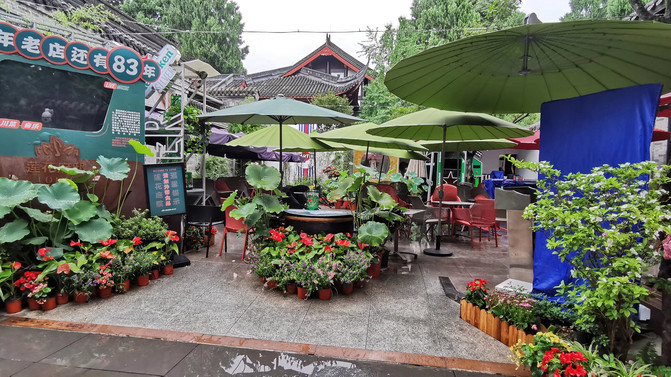
Jinli 4

Jinli 5
Nanjiao Park
Nanjiao Park is located on the west side of Wuhou Temple. It was originally the cemetery of Liu Xiang, chairman of Sichuan Province and commander of the Seventh Theater Theater during the Republic of China. It is the only northern cemeta-style building complex in Southwest China. Formerly independent park, it is now merged into Wuhou Temple Garden Area.

Liu Xiang's Tomb 1 (Tomb)
From the south gate of Jinli to the exit located outside the northwest corner of Wuhou Temple, it is facing Liu Xiang's tomb. However, the direction of the tour is in the opposite direction: tomb--Xiangdian--Stele Pavilion--Quefang--Gate.

Liu Xiang's Tomb 2 (Square)
It is said that Liu Xiang's will was buried next to Liu Bei's tomb. Because he believed that he was a descendant of Liu Bei during his lifetime and had the dragon gene, he stayed with each other after his death, which could be regarded as recognizing his ancestors and returning to his family.

Liu Xiang's Tomb 3 (Stele Pavilion)
In fact, Liu Xiang was a warlord who fought civil war in Sichuan for most of his life and did not see much effort for the "party-state". Later, he led 300,000 Sichuan troops out of Sichuan to resist the Japanese. His determination was commendable, but before much exchange of fire, he died of illness in Wuhan. The National Government gave him a "state funeral" and posthumously awarded him the title of a "first-class general", and built the tomb in accordance with the model of the Manchu Emperor Mausoleum. During the Anti-Japanese War, the Chuchuan soldiers participated in all major battles and showed bravery. More than 260,000 people died, the highest among all provinces in the country. However, they all occurred after Liu Xiang's death.

Liu Xiang's Tomb 4 (Quefang)
wuhou temple
Wuhou Temple is located in Wuhou District. It is an ancestral hall in memory of Zhuge Liang. It is named because Zhuge Liang was granted the title of "Marquis Wuxiang" during his lifetime and was posthumously named "Marquis Zhongwu" after his death. Scenic area 4A.

Wuhou Temple 1 (Gate)
In fact, this was originally Liu Bei's territory-Huiling (Liu Bei's tomb). Next to the tomb, Liu Bei's "Han Zhaoli Temple" was built to worship Liu Bei. After Zhuge Liang's death, the Wuhou Temple was built next to Liu Bei's Temple. In the Ming Dynasty, the two temples merged into one place, becoming the only temple in China where monarch and minister worship together. Perhaps Zhuge Liang was famous as the master of Shenggai. I don't know when, people changed the name of "Han Zhaolie Temple" to "Wuhou Temple". Fortunately, Zhuge Liang is dead and Shu Han is dead, so no one will hold Zhuge Liang accountable for deceiving the monarch.
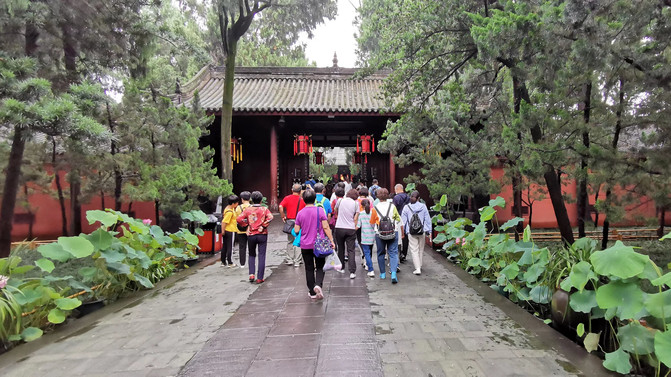
Wuhou Temple 2 (Second Gate)
The temple faces north to south, and the main buildings are arranged on a central axis. They are the gate, the second gate, the Han Zhaolie Temple, the passage hall, and the Wuhou Temple. Behind them are the moved Sanyi Temple and the newly built Jieyi Tower.

Wuhou Temple 3
The second gate is located in front of Liu Bei's Hall. The plaque is "Bright and virtuous through the ages", which means "a wise monarch and a good minister will set an example through the ages." On the left side of the word "Ming" is "Mu", not "Ri", because the person who inscribed the plaque was from the Qing Dynasty. If the word "Ming" is equated with the Ming Dynasty and it still needs to be "everlasting", I'm afraid you won't be able to keep your brain. A typo can avoid the disaster of annihilation.

Wuhou Temple 4 (Liu Bei Hall)
Liu Bei Hall, located inside the second gate, is magnificent. In the center is a gold-plated statue of Liu Bei, and on the left is a statue of his grandson Liu Chen. There was a portrait of his son Liu Chan on the right side. Because he was fatuous and incompetent, he lost his power and humiliated the country, and was moved out during the Song Dynasty. On both sides of the side halls, there are statues of Guan Yu, son and Zhou Cang on the east, and statues of Zhang Fei's ancestors and grandchildren on the west.

Wuhou Temple 5
The entrance hall is located between Liu Bei Hall and Zhuge Liang Hall. The plaque of "Wuhou Temple" hangs high, which should be equivalent to the gate of Zhuge Liang Temple.

Wuhou Temple 6 (Passing Hall)

Wuhou Temple 7 (Zhuge Liang Hall)
Zhuge Liang Hall has a plaque "Famous for the Universe" hung on it, and statues of Zhuge Liang's ancestors and grandchildren for three generations are enshrined in the main hall.

Wuhou Temple 8
The famous sentence in Zhuge Liang's "Book of Commandments to the Child" written on the top beam of the hall: "No one can have clear aspirations unless one is indifferent, and no one can have a long-term goal without tranquility." The plaques and couplets are all praises of praise.

Wuhou Temple 9 (Military Commander Corridor)
In addition to Liu, Guan, Zhang and Zhuge Liang, who enjoy special halls, there are statues of other important figures of Shu in the civil and military corridors on both sides of Liu Bei's Hall. To the east is the Civil Officials Corridor, and to the west is the Military Generals Corridor, each with fourteen civil officials and generals.

Wuhou Temple 10 (Sanyi Temple)
Sanyi Temple, located behind Zhuge Liang Hall, is large-scale. It was built in the early years of Kangxi of the Qing Dynasty. It was originally located on Dudu Street and moved to Wuhou Temple in 1998.

Wuhou Temple 11
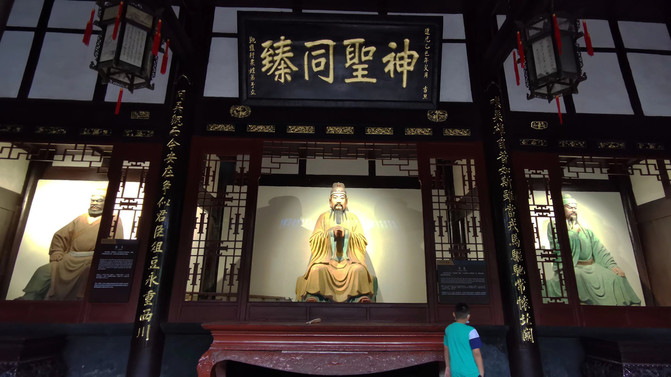
Wuhou Temple 12
Huiling is located on the west side of Wuhou Temple and connected to Wuhou Temple by red walls and roads. It is a treasure place personally selected by Zhuge Liang for Liu Bei. Liu Bei, Gan and Wu were buried in the tomb. Internal maintenance is not open.
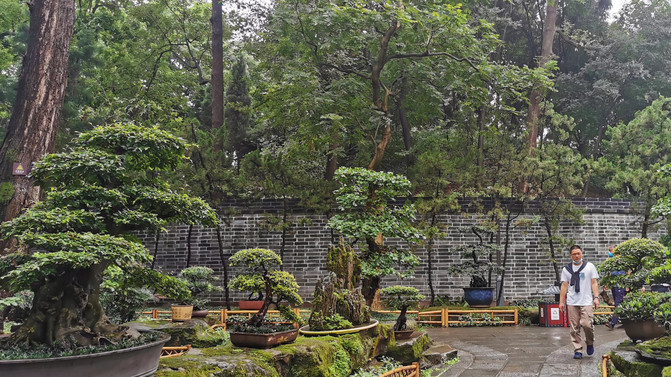
Wuhou Temple 13 (Liu Bei's Tomb)
There are many calligraphy, paintings and couplets in the Wuhou Temple, including many world-renowned works.
Du Fu caotang
Du Fu Cottage is located in Qingyang District and is the former residence of Du Fu, a poet in the Tang Dynasty. Scenic area 4A.

Du Fu Cottage 1
At that time, in order to avoid the "Anshi Rebellion", Du Fu brought his family to Sichuan and built a thatched hut in Chengdu to live in it, called the "Chengdu Cottage". Du Fu has lived here for nearly four years, and has written more than 240 poems that have been passed down to this day. Among them,"Wen Guan Jun Collected Henan and Hebei" has become a must-learn subject for students. The former residence of the Cottage is regarded as a "holy place" in the history of literature.

Du Fu Cottage 2
Du Fu Cottage now retains the pattern rebuilt during the Jiaqing period of the Qing Dynasty, covering an area of nearly 300 acres. The Daxie, Poetry and History Hall, and Works Ministry Temple located on the central axis are the three main commemorative buildings.

Du Fu Cottage 3 (Da Xie)
The "Da Xi'an" is a hall commemorating Du Fu's political experience. "Xi" is an open-hall building, an office place for ancient officials. In fact, Du Fu had a poor official career all his life and did not have much political experience. He came to Chengdu only to escape the war.

Du Fu Cottage 4 (Poetry History Hall)
The "Poetry History Hall" is a hall where Du Fu's poems are displayed. Because Du Fu's poems reflect the history of the Tang Dynasty from prosperity to decline, they are known as the "History of Poetry", and the building is named after this.

Du Fu Cottage 5 (Ministry of Industry Temple)
The "Ministry of Works Temple" is a temple where Du Fu is sacrificed. Du Fu was once awarded the title of "Zuo Shiyi" by Emperor Suzong of the Tang Dynasty, so he was called "Du Shiyi" in the world. Later, he served as "Member of the Ministry of Engineering Inspection", and later called him "Du Ministry of Engineering".

Du Fu Cottage 6
The buildings in the Cottage are simple and elegant, with a grand scale. Between the halls, corridors are surrounded by them, making it deep and peaceful.
The garden is covered by pine trees and green bamboos. It runs through flower paths in the east, water sills in the west, and pavilions, ponds and pavilions are dotted with it. It is both poetic and picturesque. It is a classical garden that combines beautiful cultural landscape and natural landscape.

Du Fu Cottage 7

Du Fu Cottage 8

Du Fu Cottage 9

Du Fu Cottage 10

Du Fu Cottage 11

Du Fu Cottage 12

Du Fu Cottage 13

Du Fu Cottage 14
Qingyang Palace
Qingyang Palace is located between Kuanzhai Alley and Du Fu Cottage in the urban area. Across the road from the hotel where you stay, it is known as the "No. 1 Taoist Temple in Western Sichuan".

Qingyang Palace 1
Since the Han Dynasty, there is today a market in Qingyang Palace, which mainly sells black (green, black) sheep-Qingyang Si.

Qingyang Palace 2
In the early years of the Tang Dynasty, a Taoist temple-Xuanzhong Temple-was built here.

Qingyang Palace 3

Qingyang Palace 4
At the end of the Tang Dynasty, the Huangchao Rebellion Army invaded Chang 'an. Li Xi, the Emperor of the Tang Dynasty, fled to Chengdu and lived in Xuanzhong Temple for four years. After returning to Chang 'an, I was grateful for observing the years and gave me 2 million yuan in silver to expand my cultivation. Because the emperor had lived there,"Guan" was changed to "Gong" and named it "Qingyang Palace".

Qingyang Palace 5

Qingyang Palace 6
Most of the existing ones were repaired and rebuilt in the Qing Dynasty.

Qingyang Palace 7

Qingyang Palace 8
Qingyang Palace is quite large in scale, with grand buildings. The main body is six important on the same central axis. It mainly includes the Mountain Gate, Hunyuan Hall, Bagua Pavilion, Sanqing Hall, Doumu Hall, Zijin Terrace, Shengsheng Terrace and Shuan Terrace.

Qingyang Palace 9
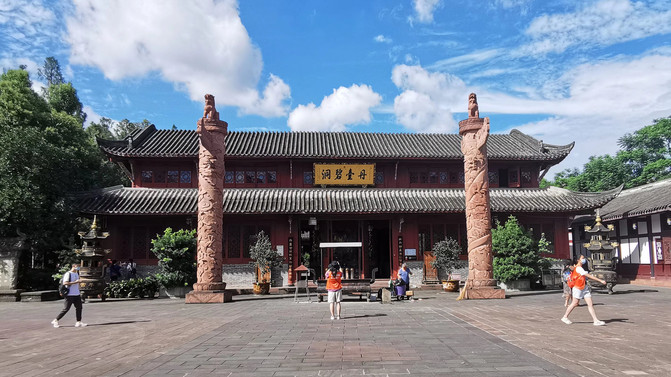
Qingyang Palace 10
There is a cultural park next to Qingyang Palace, which is a place for citizens to relax.

Cultural Park 1

Cultural Park 2

Cultural Park 3

Cultural Park 4
On July 11, I left Chengdu in the morning and headed for Malkam. On the way, I visited the Dujiangyan and Yingxiu earthquake sites.
Dujiangyan
Dujiangyan is 70 kilometers away from Chengdu and is located on the Minjiang River in the west of Dujiangyan City. It was the world's earliest and still in use water diversion project organized and built by Li Bing, the prefect of Shu Prefecture, and his son more than 2,200 years ago. It is listed as a World Cultural Heritage Site and a 5A-level scenic spot.

Dujiangyan 1

Dujiangyan 2
There are many scenic spots currently being developed in Dujiangyan Scenic Area. Due to time constraints, we only visited the water conservancy project part this time.

Jiangyan 3
The Dujiangyan Water Conservancy Project mainly consists of three parts: water diversion fish mouth, flying sand weir and treasure bottle mouth.

Jiangyan 4
The fish mouth is at the front end of the water diversion embankment and is named because it is shaped like the head of a fish. It divides the river water into two streams. The western stream is called the Outer River and discharges along the Minjiang River; the eastern stream is called the Inner River and flows into the Chengdu Plain through the Baopingkou.
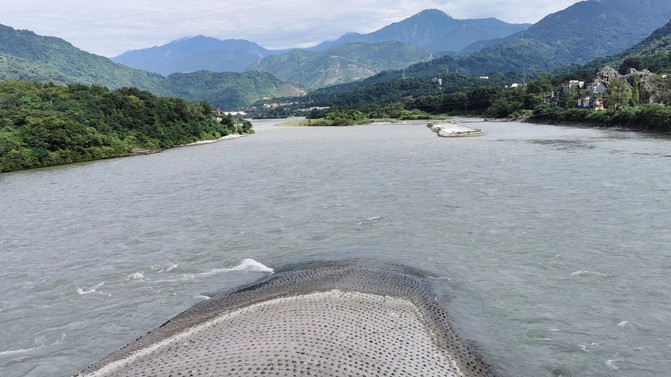
Dujiangyan 5

Dujiangyan 6

Dujiangyan 7
The outer river bed is wide and high, while the inner river bed is narrow and low. In the dry season, 60% of the river water flows into the inner river, ensuring water use in the Chengdu Plain; when floods come, most of the river water is drained away from the outer river with the wider river surface to prevent floods in the Chengdu Plain. This design of automatic allocation of water is called "four-six water diversion".

Dujiangyan 8

Dujiangyan 9
Baopingkou is the outlet of Neijiang water to the Chengdu Plain. Before gunpowder was invented, Li Bing and his son used the method of burning stones to carve a mountain pass 20 meters wide, 40 meters high and 80 meters long in Yulei Mountain on the east bank of the Inner River. Because it is shaped like a bottle, it is named "Treasure Bottle Mouth".

Dujiangyan 10
Feisha Weir is an overflow weir dam built near Baopingkou. The waterway in front of the dam is curved, forming a circulation vortex. The huge centrifugal force rolls up the mud and sand on the river bed across the weir dam and throws it into the outer river, reducing the silting of the Baopingkou river, so it is named "Flying Sand Weir". A bridge has been built in front of the current location of Feisha Weir.

Dujiangyan 11
Flying sand weir also plays a role in regulating the water volume. When the water level of the inner river is too high, the flood overflows the weir and enters the outer river. When the water level of the inner river is low, the river water is blocked from discharging and all flows into the Baopingkou to ensure water use in the irrigation area and avoid floods.

Dujiangyan 12
The tour route this time is to enter from the Lidui Gate, cross the Feisha Weir, follow the east bank of the Outer River to the Fenshui Yuzui, and then return along the west bank of the Inner River, cross the Anlan Bridge, visit the Erwang Temple, take the Songmao Ancient Road, cross the pedestrian street, cross the South Bridge, and return to the gate of the Lidui Scenic Area.

Dujiangyan 13

Dujiangyan 14

Dujiangyan 15
Dujiangyan 16

Dujiangyan 17
Sichuan does not lack rivers, but due to mountain barriers, the Chengdu Plain was once a water-deficient and arid area. After Li Bing and his son organized the construction of Dujiangyan, they have been playing a role in flood control and irrigation for more than 2,000 years, making the Chengdu Plain a "land of abundance" with vast expanse of land.

Dujiangyan 18
The irrigated area of Dujiangyan still covers 10 million acres, benefiting more than 30 counties and cities.

Dujiangyan 19
Wenchuan earthquake sites
Yingxiu Town, Wenchuan County is located 30 kilometers northwest of Dujiangyan. It is located at the Sancha intersection of National Roads G213 and G350. Yuzixi joins the Minjiang River here. It is in a superior location and is a very prosperous town in the area.
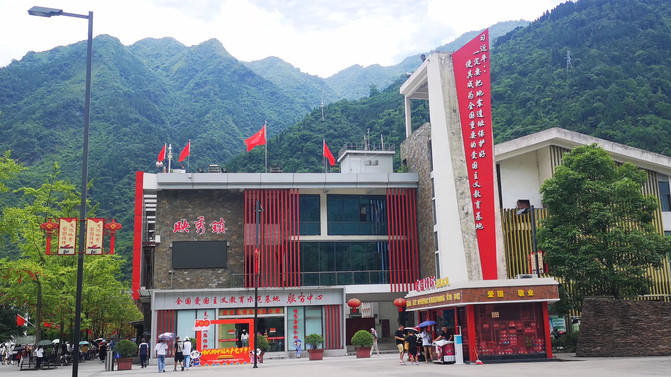
Yingxiu 1
The epicenter of the 2008 "Wenchuan Earthquake" was in Yingxiu, with a magnitude of 8.0. It affected more than 230 counties, killing more than 69,000 people, missing more than 18,000 people, and injuring more than 370,000 people. The total population affected exceeded 46 million. More than 5,400 people were killed in Yingxiu.

Yingxiu 2
Xuankou Middle School is located in Yingxiu Town. More than 1,500 students were in class during the earthquake. 45 students and 10 faculty members were killed. The earthquake site has been preserved relatively completely. The casualty rate of Xuankou Middle School is not high. Half of the more than 400 students in Yingxiu Primary School were killed.

Yingxiu 3
Entering the gate of the site, what is shown is the ruins and broken walls.

Yingxiu 4
The main teaching building has been toppled, and the stone clock on the front steps of the building is fixed at 14:28 on May 12, 2008.

Yingxiu 5

Yingxiu 6
The five-story lecture classroom was stacked only one story high, and the five-story student dormitory building also collapsed. It is said that the bodies of more than 20 teachers and students still have not been cleared out under the ruins.

Yingxiu 7
The ruins show tourists the miserable scene of Yingxiu with beautiful mountains and clear waters being instantly destroyed.

Yingxiu 8

Yingxiu 9
After more than 20 years, Yingxiu Town has restored its prosperity. The houses built by the government are even more beautiful. Earthquake sites have become must-visit check-in points for tourists from Chengdu north. Many families in the town have opened more family hotels and restaurants. Yingxiu people, who were lucky enough to escape the disaster, live a luckier life.

Yingxiu 10

Yingxiu 11
(To be continued)
Previous Article:Part 5 of Self-driving Tour Home for the New Year--Pinming Tea in Yuantong Old Street
Next Article:Chengdu's best strategies for eating, drinking and having fun at the end of 2020
